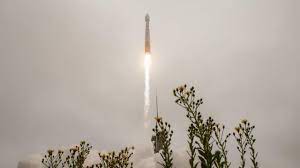NASA successfully launched Landsat 9, a satellite made by NASA to monitor the Earth’s land surface. The satellite was successfully launched at 2:12 pm EDT, that is at 11:42 pm IST, on Monday. The satellite was launched from the Vandenberg Space Force Base, which is located in California. This mission was a joint mission along with the U.S. Geological Survey (USGS). The satellite was lifted off on a United Launch Alliance AtlasV rocket and was launched from the Vandenberg’s Space launch complex 3E. About 83 minutes after the launch, the signals from the spacecraft were acquired by the Svalbard satellite monitoring ground station, located in Norway. According to the reports of NASA, Landsat 9 is performing in the same way as expected. It also traveled to its final orbital altitude of 438 miles, that is, 705 kilometers.
According to the Administrator of NASA, Bill Nelson, “NASA uses the unique assets of our own unprecedented fleet, as well as the instruments of other nations, to study our own planet and its climate systems.” further said, “With a 50-year data bank to build on, Landsat 9 will take this historic and invaluable global program to the next level. We look forward to working with our partners at the U.S. Geological Survey and the Department of the Interior again on Landsat Next because we will never stop advancing our work to understand our planet.”
On this successful launch of Landsat 9, the secretary of the interior, Deb Haaland, said, “Today’s successful launch is a major milestone in the nearly 50-year joint partnership between USGS and NASA who, for decades, have partnered to collect valuable scientific information and use that data to shape policy with the utmost scientific integrity.” According to the reports provided by NASA, the secretary further continued, “As the impacts of the climate crisis intensify in the United States and across the globe, Landsat 9 will provide data and imagery to help make science-based decisions on key issues including water use, wildfire impacts, coral reef degradation, glacier and ice-shelf retreat, and tropical deforestation.”
Talking about the instruments that aboard Landsat 9, the Operational Land Imager 2 (OLI-2) and the Thermal Infrared Sensor 2 (TIRS-2), will help to measure around 11 wavelengths of light radiated or reflected off the Earth’s surface, in the visible spectrum and also the wavelengths which our eyes can’t detect. The instruments in the satellite will help to capture images across 115 miles (i.e, 185 km), and each pixel in the photo will show an area of 30 meters across, that is, about the size of a baseball infield. Resource managers can also identify the most crop fields in the US at a height resolution.
And about the satellite, the first Landsat satellite was launched in 1972, and since then, NASA always manages to keep a Landsat continuously in an orbit only able to provide pictures of material that covers Earth’s surface and changes to land usage. The images help researchers to keep an eye on the phenomenons like agriculture productivity, water quality, glacier dynamics, etc.
Landsat satellites have been observing Earth for over 50 years, and have also provided records. The data provided by satellites always helps to plan the future in a changing climate, according to Karen St. Germain, the director of the Earth Science Division at NASA. Now this Landsat 9 will join along with its sister satellite, Landsat 8 in orbit. These two satellites together will help to provide images by spanning Earth every eight days. The Landsat images and data are publicly available and free, and this has resulted in more than 100 million downloads since 2018.


